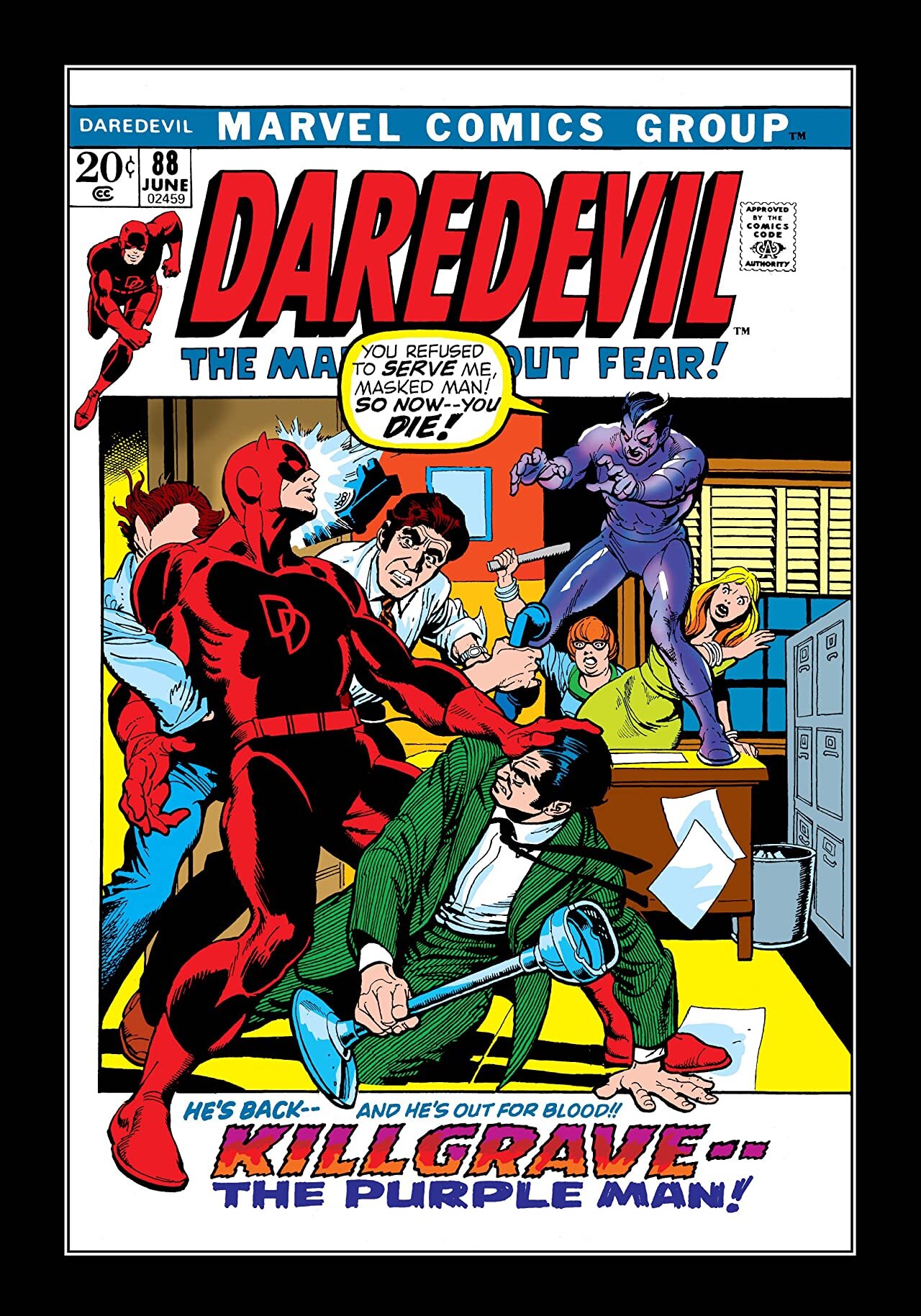The Man Without Fear...By The Year: 1972
By Bruno Savill De Jong — It’s 1972. Atari releases PONG, the Watergate scandal erupts, and tragedy strikes at the 1972 Munich Olympics. People are listening to “Lean on Me,” watching The Godfather, and reading Daredevil.
Written by Gerry Conway
Illustrated by Gene Colan
Inks by Syd Shores (85), Tom Palmer (86-94)
Colors unknown/unlisted
Lettered by Artie Simek (86, 91), Sam Rosen (87, 90), Jon Costa/John Costanza (85, 88-89, 92-94)
The year 1972 was one transitions. At least in Marvel Comics. This is the year Phil Seuling engineered the “direct market” via Sea Gate Distributors. It’s also when Marvel expanded to form their British publishing arm, Marvel UK, and Stan Lee ascended to become Marvel’s publisher, while his protégé Roy Thomas became Editor-in-Chief. Both men had worked on Daredevil. 1972 is also when Gerry Conway first took Matt Murdock out of New York and relocated him to San Francisco with his newfound “partner” Natasha Romanoff, retitling the book “Daredevil and the Black Widow.” Apparently the series sales were struggling, and bringing aboard the red-headed femme fatale and remixing the title would boost interest, alongside moving to a less superhero-dense locale.
Even before the title-change, 1972’s first issue* takes place onboard an airplane (briefly hijacked by the Gladiator) when Matt and Natasha return from Switzerland, ready to transition into their new life together. That is until a chance encounter with Karen Page at the airport sends her and Matt running back into each other’s arms. Change is hard, it seems.
*OK, technically Daredevil #85 was March 1972, since Daredevil #83-84 were folded into the discussion of 1971.
Matt and Karen are each other’s Last Temptation, a glimpse of their previous dreams (having last seen each other in Daredevil #67) that make them cast off current prospects, Black Widow and Paul respectively. They are determined they have “rediscovered” one another, throwing a lavish engagement party in Daredevil #86 to demonstrate their commitment and contentment. The two surrender to the past. But the past also threatens them, in the form of the Ox, still body-swapped with Dr. Karl Stragg from way back in 1966’s Daredevil#15, who vows revenge against Nelson & Murdock for his incarceration and subsequent experimental radiation poisoning (which grants him early parole).
The Ox is desperate to have his former original body, which the internal radiation mutates and manifests, albeit in a monstrous way. Like Karen and Matt, the Ox is obsessed with the past – his past body and past misfortune – and it twists and torments the Ox into a decomposed version of his former self. Karen and Matt, on some subtextual level, realize they must relinquish their own past relationship lest it also become decrepit. It’s not the Ox’s attacks in and of themselves that threatens their engagement, but how it highlights their new priorities, with Karen unable to silently sit by as Matt works as Daredevil. “There’s no room for a swashbuckling adventurer in the life of a movie star,” Matt concedes, while Karen admits they’ve been trying to “recapture a past [they’ve] left behind.” Karen then ‘hands’ Matt off to Black Widow, waiting outside, letting her past relationship with Matt remain a beautiful memory, rather than let it spoil a fresh future.
So, moving across the continent to San Francisco is a clean slate for Daredevil, establishing a new environment and supporting cast away from the baggage of New York. Although as Colin Smith notes in his (excellent) deep-dive into Conway’s Daredevil in San Francisco, these stories are most notable for what they lack. Early ‘70s San Francisco was a hotbed of counterculture (including the centre of the Underground Comix movement) and a “Gay Mecca” of progressivism – Harvey Milk moved to San Francisco the same year as Daredevil. But Daredevil and the Black Widow doesn’t quite integrate this new setting, using the city as a fairly standard backdrop whose defining feature is it isn’t New York. When Daredevil visited L.A., it referenced Hollywood and the Tar Pits. But San Francisco is a negation, Matt’s escape-route from Karen and his old life. And being an absence means Matt cannot embrace it on its own terms. Swinging around its most famous monument, all Daredevil can say about the Golden Gate Bridge is “it’s a bridge – just like any other bridge.” Matt wants to reinvigorated by this new setting, but finds it depressingly uninspiring.
The interesting subtext of 1972’s Daredevil and the Black Widow is Matt’s petulant inability to change with the times. He goes along with Natasha buying them a house together in San Francisco, or accepting an offer from law firm Roderick, Sloan & Cranston, but rarely of his own initiative. Colin Smith views Matt as undergoing a “crisis of masculinity”, unable to find his footing and increasingly distraught by his failures. When kidnapped and defeated by Killgrave the Purple Man, and rescued by Natasha’s paternalistic chauffeur Ivan, Matt self-admonishes that “the Man Without Fear… blew it!” His subsequent defeat of the Purple Man is used to reinforce his prior attitudes, exclaiming “maybe that’s what the world needs more of – gallant superheroes! Somehow, I don’t think Gloria Steinem would approve.”
Daredevil may change cities but he doesn’t change his attitude. He’s domineering and arrogant against both criminals (dismissing Electro’s “inferiority crisis”) and cops (even hitting his friend on the force, Lieutenant Paul, for trying to talk with him). Daredevil even transfers over his secret-identity issues, as both the new Mr Fear and reports comment it “wasn’t hard” to connect the dots of Matt Murdock moving to San Francisco with the public superheroine Black Widow, who is also teaming up with the newly arrived Daredevil. Matt simply recycles the excuse of Daredevil being a close friend and uses Black Panther as a stand-in. Daredevil may be on a new coast, but his tactics and outlook remain the same.
Daredevil’s conservative and single-minded attitude is most apparent in his treatment of the Black Widow. To be fair, Daredevil and the Black Widow itself seems muddled about their exact relationship; Natasha moves her and Matt (and Ivan) into a grand manor which “cost every last penny of [her] inheritance,” but she also makes it clear she and Matt will be sleeping on separate floors. Although crime-fighting “partners,” Matt and Natasha rarely work together in 1972, with her often estrangement from him and working on her own secret projects, or brainwashed to fight against Daredevil. Matt usually remains at the forefront, with Natasha even stopping the police, and herself, from joining Daredevil’s fight against Electro.
Daredevil therefore regards Natasha as a “sidekick” who he wants to “have” but rarely considers the feelings of, being patronisingly “concerned” about her being left alone either for her “safety” or out of “jealousy”. Neither are good options. At one point Matt believes Natasha has “left” him and he throws a fit, but Ivan points out ““if you really cared about ‘Tasha you’d be out looking for her – instead of bustin’ up this place like some sorta love-sick punk.” Even Black Widow becomes self-aware of her marginalization and, frankly, Daredevil’s ingratitude towards her, telling Matt “You never thank me - - never accept me for what I am - - a person - - someone apart from you - - someone who acts and reacts for her own reasons - - not just yours! I’ve been your partner, Mr Murdock - - But you haven’t been mine!”
Even if the scripts downplay her involvement, Black Widow comes across better in Daredevil and the Black Widow. Like Daredevil, she is also running from her past, running into old colleague Danny French in San Francisco, who reminds her of the mysterious “Project Four” mission for her Soviet spy days. But unlike Daredevil, Natasha does not ignore or wallow in her past, but actively seeks to confront and resolve it. Maybe Daredevil is well-intention in his desire to interfere with this, but Natasha sees it as patronizing, telling him “I am not your kid – I am not anybody’s kid” and asserting her autonomous self-identity.
In contrast to Daredevil’s dismissal of the famed feminist, onlooking women label Natasha the “Gloria Steinem of the jump-suit set.” At the start of 1972, Natasha cannot help follow Matt around even after he’s tossed her aside for Karen. But as their time together continues, Natasha begins asserting more autonomy and individuality, informing Matt of this complicated mixture of affection and self-assertion; “In case you hadn’t noticed, Matt – much as I think I love you – I’m my own woman – first, last, and always!”
Black Widow’s “Project Four” hangs over their 1972 in San Francisco, slowly teased out in the background as Daredevil fights the likes of Electro and the Purple Man, who both just happen to have relocated at the same time as Daredevil. Daredevil and Black Widow are also hit by waves of terror, initially thought as part of Project Four, but actually from the new Mr Fear (now the third), revealed to be Matt’s jealous law schoolmate Larry Cranston. All of 1972’s villains suffer unstable inferiority complexes, in their own way, from Cranston feeling undermined by Matt’s prowess to Electro being diagnosed with schizophrenic “inferiority problems.”
Such is particularly true of Project Four’s true mastermind, Damon Dran, who commissioned it as an unlimited energy source to shelter himself from the “inevitable” WW3 and become “the Indestructible Man,” Dran directly comments on the paranoid thinking of Cold War “Mutually Assured Destruction,” wishing to be “truly free from the terrors of their petty warfare.” Even if being ‘above’ humanity’s warfare only further enables it, as Natasha tells Dran, “instead of helping to avert atomic catastrophe, you sought to escape it – first by ordering the construction of Project Four – then by using the project’s Energy Globe to make yourself a thing outside of the rest of humanity.” Dran’s desire to become “indestructible” – to be immune from change – has led to his transformation and causes havoc in San Francisco.
Having acquired the Energy Globe, Dran grows increasingly larger and more powerful as he stomps around San Francisco, requiring Danny French to heroically sacrifice himself with “one final – and fatal – transformation.” 1972 is an odd transition for Daredevil (now and the Black Widow), adapting to a new location and dynamics. Daredevil’s charge into a clean slate is still haunted by his old life, the faces he no longer sees. 1972’s Daredevil and the Black Widow can be frustrating to read, but there’s interesting subtext in how its central characters try to relocate themselves, even if its unintentional. Change is hard. Comics, and comic book characters, are more resistant than most. But even these transformations, and the lack thereof, can reveal interesting layers of the characters facing them.
Check out past installments from The Man Without Fear…By The Year!
Check out Bruno Savill De Jong’s last regular series, Gotham Central Case by Case!
Bruno Savill De Jong is a recent undergraduate of English and freelance writer on films and comics, living in London. His infrequent comics-blog is Panels are Windows and semi-frequent Twitter is BrunoSavillDeJo.













